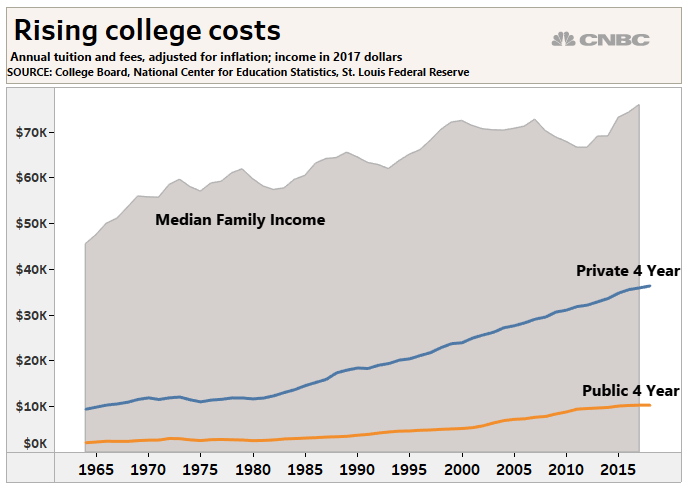Andrew Sacks | Getty Images
The Class of 2019 has a lot to be proud of, and a hefty bill to show for it.
For newly minted graduates, their college education is the second-largest expense they'll likely have in their lifetimes — right after purchasing a home.
Tuition and fees for a four-year private college averaged $35,830 in 2018-19; at four-year in-state public colleges, it was $10,230, according to the College Board. And that doesn't count room and board or other expenses.
Tuition has historically risen about 3% to 5% a year, according to the College Board. However, during the recession, declining public funds caused tuition to skyrocket.
Over the last decade, tuition and fees rose 44% at four-year, private colleges and by 55% at public four-year schools, where students were harder hit, according to a report by GoBankingRates.
In the worst year during this period, for example, the average cost of private four-year schools rose 4.1% in 2011-12 to $27,880, from $26,770 the prior year, and the cost of four-year public schools reached $8,280, up 8.5% from $7,630 the year before, GoBankingRates found. (Check the cost of college the year you graduated.)
To see just how much the price of a postsecondary education has increased, the personal finance website analyzed data from the National Center for Education Statistics and the College Board going back to 1964.
In 1964-1965, the cost of a four-year private school was $1,160 per year, on average. From 1964 to 2019, the cost of tuition jumped just under 3,000%. Meanwhile, the cost of a four-year public school soared to just over 3,800%, from a mere $261 annually, GoBankingRates said. (Costs are in current dollars.)
The significant increase in college costs has outpaced inflation and far outpaced family income over decades (see the chart below).

More from Personal Finance:
The best schools for financial aid
The latest victims of the student debt crisis — parents
Here's how US college costs stack up to the world
via IFTTT
No comments:
Post a Comment